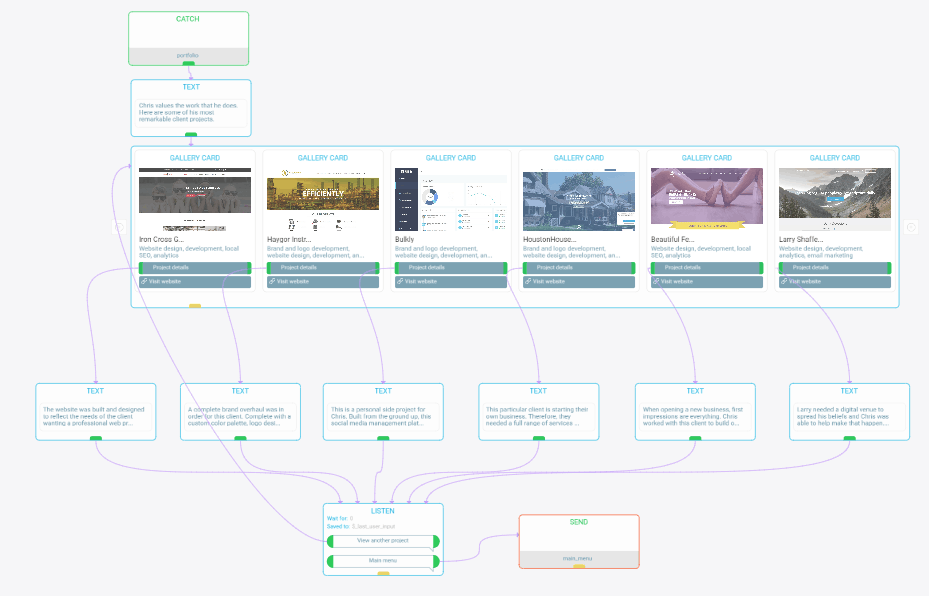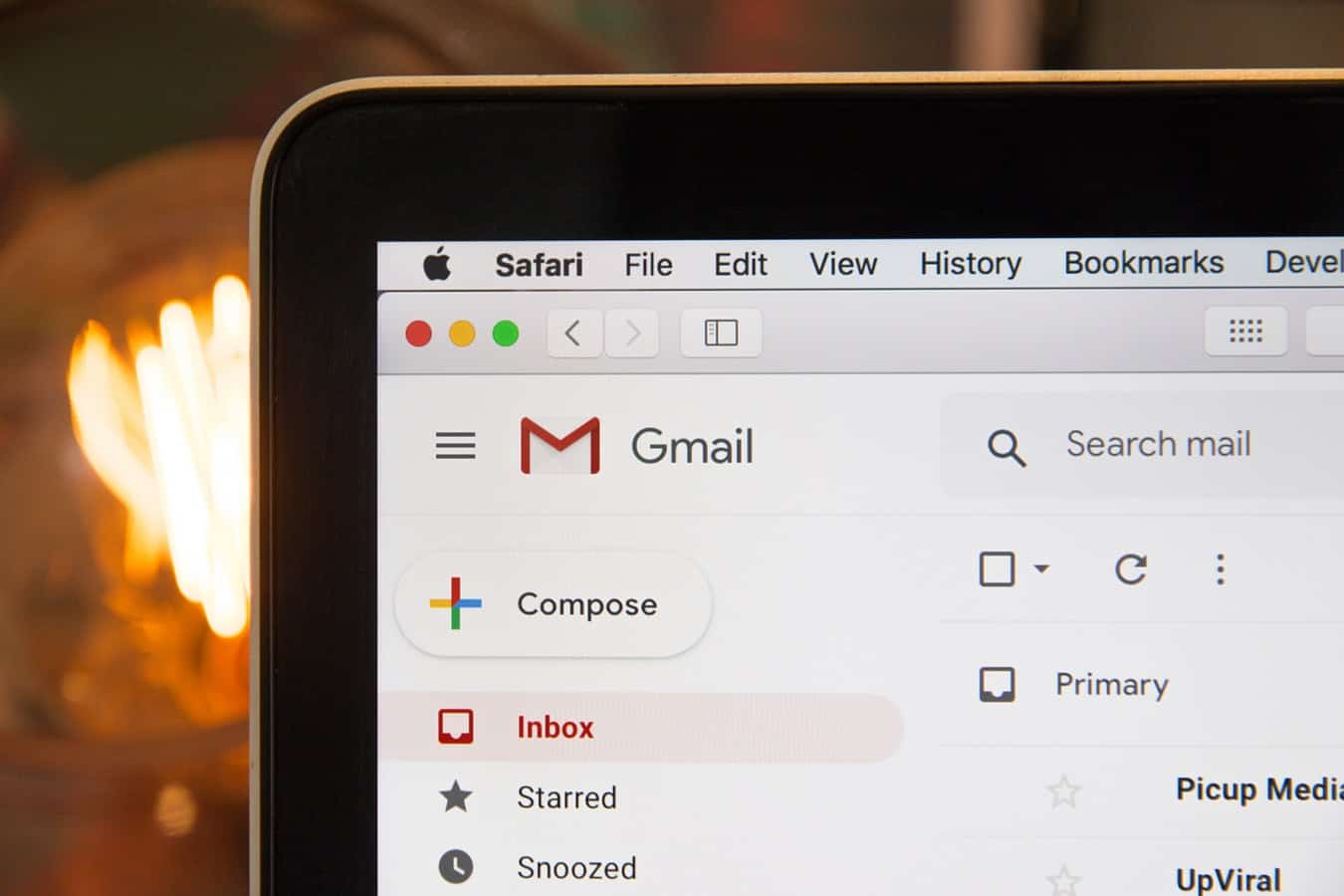Interested in how to build a chatbot?
In this post, I'll cover everything there is to know about chatbots.
But first things first...what is a chatbot?
We all have an image that pops up in our heads when we think of chatbots.
Maybe it’s inspired by where we’ve seen (or think we’ve seen) them used in the past…or perhaps hearing the word conjures up random images of tiny robots we remember from a cell phone commercial or sci-fi special.
Or maybe you already have a general understanding of what chatbots really are, but you want to know how you can make one work for your business.
Whatever your knowledge level is, this post is designed to give you a streamlined crash course on all things chatbot – what they are, why businesses use them, how they work, etc.
Ready to see how to build a chatbot?
Let's get started.

 Some companies have handled space challenges by implementing large, warehouse-like call centers or allowing certain representatives to work remotely.
But long waits on the phone continue to be an issue.
Online support via e-mail or human-managed chatboxes relieves some of the burden on call centers.
Some companies have handled space challenges by implementing large, warehouse-like call centers or allowing certain representatives to work remotely.
But long waits on the phone continue to be an issue.
Online support via e-mail or human-managed chatboxes relieves some of the burden on call centers.
 Even if the consumer demand on your business is easily handled by your regular support staff, supplemented by seasonal reps during periods of high-demand, there may be a time when no one is available to help.
Maybe it’s late at night and everyone’s gone home for the day.
Or perhaps you have customers in another country, with only a small time frame available to speak with support staff.
By implementing a chatbot on your website, you can offer these customers round-the-clock support – without the expense of adding another shift or hiring more people.
Even if the consumer demand on your business is easily handled by your regular support staff, supplemented by seasonal reps during periods of high-demand, there may be a time when no one is available to help.
Maybe it’s late at night and everyone’s gone home for the day.
Or perhaps you have customers in another country, with only a small time frame available to speak with support staff.
By implementing a chatbot on your website, you can offer these customers round-the-clock support – without the expense of adding another shift or hiring more people.
 Not everyone that lands on your website will be a returning visitor.
Some people might have just heard your company name somewhere or been referred to your site by a friend. Therefore, while they know what they ultimately want from you, they may not have any clue as to what steps to take to get there.
Or maybe they aren’t picking the best option to meet their specific needs, due to a lack of knowledge.
A chatbot can talk customers through a basic set of exploratory questions to help them get going in the right direction.
For example, say you’re a custom printing company.
Not everyone that lands on your website will be a returning visitor.
Some people might have just heard your company name somewhere or been referred to your site by a friend. Therefore, while they know what they ultimately want from you, they may not have any clue as to what steps to take to get there.
Or maybe they aren’t picking the best option to meet their specific needs, due to a lack of knowledge.
A chatbot can talk customers through a basic set of exploratory questions to help them get going in the right direction.
For example, say you’re a custom printing company.
 Similar to how chatbots can be used to help guide customers toward the best solution for their needs, they can also be used to encourage visitors to subscribe to your blog or newsletter.
In this case, it’s best to place a chatbox pop-up on a blog page where active readers will be likely to see it.
It might be used to ask for feedback with the intention of starting a conversation that eventually leads into telling readers where they can subscribe.
By gaining subscribers, not only are you earning your brand a spot in this potential customer’s inbox as a recurring marketing opportunity, but you’ve also now captured their contact information to be added to a drip campaign or used for future sales messaging opportunities.
Similar to how chatbots can be used to help guide customers toward the best solution for their needs, they can also be used to encourage visitors to subscribe to your blog or newsletter.
In this case, it’s best to place a chatbox pop-up on a blog page where active readers will be likely to see it.
It might be used to ask for feedback with the intention of starting a conversation that eventually leads into telling readers where they can subscribe.
By gaining subscribers, not only are you earning your brand a spot in this potential customer’s inbox as a recurring marketing opportunity, but you’ve also now captured their contact information to be added to a drip campaign or used for future sales messaging opportunities.
 There aren’t that many ways to make a customer service phone call or e-mail inquiry a unique and memorable experience.
Even with charismatic representatives and quick replies, the process is always essentially the same: call, talk, solve/get transferred for additional help, talk, get put on hold, etc., or the back-and-forth exchange that’s standard with any e-mail interaction.
But chatbots are an entirely new playing field.
Even though “rules” must be followed to some degree in order for the program to work effectively, communications can support features that aren’t typical to your average brand interaction.
There aren’t that many ways to make a customer service phone call or e-mail inquiry a unique and memorable experience.
Even with charismatic representatives and quick replies, the process is always essentially the same: call, talk, solve/get transferred for additional help, talk, get put on hold, etc., or the back-and-forth exchange that’s standard with any e-mail interaction.
But chatbots are an entirely new playing field.
Even though “rules” must be followed to some degree in order for the program to work effectively, communications can support features that aren’t typical to your average brand interaction.
 Let’s face it, your sales reps are much more engaging (and happier) when they aren’t cold calling day in and day out.
They get sick of asking the same qualifying questions over and over because, well, they’re human.
But chatbots aren’t human.
They can ask that same set of questions repeatedly, all day long, and still respond with the same level of enthusiasm and patience.
So it makes sense to leverage a chatbot’s basic step-by-step messaging ability to ask site visitors a series of exploratory questions as to why they’re there, what their needs/pain points are and what they value most from a product or service provider.
Feedback generated in these exchanges can be used to update marketing collateral to better reach prospects or supplement sales rep training programs.
Let’s face it, your sales reps are much more engaging (and happier) when they aren’t cold calling day in and day out.
They get sick of asking the same qualifying questions over and over because, well, they’re human.
But chatbots aren’t human.
They can ask that same set of questions repeatedly, all day long, and still respond with the same level of enthusiasm and patience.
So it makes sense to leverage a chatbot’s basic step-by-step messaging ability to ask site visitors a series of exploratory questions as to why they’re there, what their needs/pain points are and what they value most from a product or service provider.
Feedback generated in these exchanges can be used to update marketing collateral to better reach prospects or supplement sales rep training programs.
Chapter 1
What is a chatbot
A chatbot is essentially a program that uses machine-learning and pre-constructed “rules” to automatically respond to user-generated messages. A pretty broad definition, yes, but it’s fitting, as chatbots are used on a huge range of websites and digital platforms, for all kinds of different reasons. Ever asked Siri, Alexa, etc. any question, about anything at all? Those are a few obvious examples of chatbots. Clearly, you have to follow a few standard guidelines when making requests in order to get a satisfactory response, such as starting your questions with the bot’s name, speaking clearly, using common terms vs. obscure slang… But for the most part, these programs are built to hone-in on keywords and generate responses accordingly. For example, take a look at this sequence flow of the bot that is currently running on my website.
You can test the bot by clicking here.Other examples of everyday situations where you may be depending on a chatbot’s use include scheduling an Uber ride, ordering a pizza via the Pizza Hut or Dominos app and communicating through an automated customer service chatbox featured on a retail or service company’s website. Whether you’re truly familiar with what a chatbot is or is not, as you can see, you’ve probably been engaging with them for years now without giving the concept much more than a fleeting thought.
Chapter 2
Chatbot Use Cases
If you want to drill down to basics, chatbots were essentially created to serve as a solution to the heavy burden placed on companies’ customer service associates. Think about it - with the onset of e-commerce, the number of sales, interactions, questions and requests being transacted and responded to every second is multiple times that of what could have ever been managed by the on-the-clock staff of a single brick-and-mortar business of the past. These days, a clothing company can be headquartered in Los Angeles, California, and have service representatives answering questions from customers in Beijing, Stockholm and Sydney, helping customers in Washington D.C. and Honolulu make purchases online and following up on order inquiries on products that are being shipped to Orlando, Munich and Athens. If every one of those customers speaks to a service rep to ask their questions or resolve their claims, the clothing company would have to double, triple, quadruple (you get the picture) their staff to keep up. That gets expensive, sometimes prohibitively expensive. Additionally, companies may not have the office space to house that many employees. Some companies have handled space challenges by implementing large, warehouse-like call centers or allowing certain representatives to work remotely.
But long waits on the phone continue to be an issue.
Online support via e-mail or human-managed chatboxes relieves some of the burden on call centers.
Some companies have handled space challenges by implementing large, warehouse-like call centers or allowing certain representatives to work remotely.
But long waits on the phone continue to be an issue.
Online support via e-mail or human-managed chatboxes relieves some of the burden on call centers.
But at the end of the day, the central problem still exists: The number of customers to representatives is way too high to be reasonably managed.That’s where chatbots come in. These automated programs can be built into online chatboxes or smartphone apps to help serve the basic, everyday customer requests that tie up phone lines. If the majority of these basic requests can be resolved through a series of automated messages, then reps can be freed up to handle the more complicated claims and issues needing human attention. So that’s the first major business use of chatbots, in a nutshell. But they can do so much more. Here’s a breakdown of some of the most significant ways businesses use chatbots.
Deliver 24/7 customer support
 Even if the consumer demand on your business is easily handled by your regular support staff, supplemented by seasonal reps during periods of high-demand, there may be a time when no one is available to help.
Maybe it’s late at night and everyone’s gone home for the day.
Or perhaps you have customers in another country, with only a small time frame available to speak with support staff.
By implementing a chatbot on your website, you can offer these customers round-the-clock support – without the expense of adding another shift or hiring more people.
Even if the consumer demand on your business is easily handled by your regular support staff, supplemented by seasonal reps during periods of high-demand, there may be a time when no one is available to help.
Maybe it’s late at night and everyone’s gone home for the day.
Or perhaps you have customers in another country, with only a small time frame available to speak with support staff.
By implementing a chatbot on your website, you can offer these customers round-the-clock support – without the expense of adding another shift or hiring more people.
Help customers navigate – and make the right choices.
 Not everyone that lands on your website will be a returning visitor.
Some people might have just heard your company name somewhere or been referred to your site by a friend. Therefore, while they know what they ultimately want from you, they may not have any clue as to what steps to take to get there.
Or maybe they aren’t picking the best option to meet their specific needs, due to a lack of knowledge.
A chatbot can talk customers through a basic set of exploratory questions to help them get going in the right direction.
For example, say you’re a custom printing company.
Not everyone that lands on your website will be a returning visitor.
Some people might have just heard your company name somewhere or been referred to your site by a friend. Therefore, while they know what they ultimately want from you, they may not have any clue as to what steps to take to get there.
Or maybe they aren’t picking the best option to meet their specific needs, due to a lack of knowledge.
A chatbot can talk customers through a basic set of exploratory questions to help them get going in the right direction.
For example, say you’re a custom printing company.
A customer, Sara, hears about your company on a radio commercial and navigates her way to your website via Google search. She knows she wants to create a special birthday card for her son’s 5th birthday, but she has no idea how to get started.A few seconds later, a chat window pops up asking her if she would like assistance creating her first greeting card. She replies yes, and answers additional questions as the bot explains how to choose a template and add colors, designs and copy. After a few minutes, Sara closes the chatbot and starts creating her card. In this case, the company’s use of a chatbot may have alleviated one less call from their busy phone queue. Or, perhaps they avoided losing Sara as a customer due to her leaving the site after a few minutes of not finding what she was looking for. In addition to helping customers navigate their way to solutions, chatbots can also be used to help them make the best decision possible. In a different take on the example above, the initial bot may walk Sara through a few exploratory questions to pinpoint the product type that will best serve her needs. These questions may reveal that rather than a birthday card that her young son may not be that interested in reading, a big, colorful banner to hang at the party may be a much more satisfactory solution. Happy customers are good, but happier customers are better. By implementing a chatbot, you can help customers find solutions that will push their satisfaction to the next level.
Inspire more subscriptions
 Similar to how chatbots can be used to help guide customers toward the best solution for their needs, they can also be used to encourage visitors to subscribe to your blog or newsletter.
In this case, it’s best to place a chatbox pop-up on a blog page where active readers will be likely to see it.
It might be used to ask for feedback with the intention of starting a conversation that eventually leads into telling readers where they can subscribe.
By gaining subscribers, not only are you earning your brand a spot in this potential customer’s inbox as a recurring marketing opportunity, but you’ve also now captured their contact information to be added to a drip campaign or used for future sales messaging opportunities.
Similar to how chatbots can be used to help guide customers toward the best solution for their needs, they can also be used to encourage visitors to subscribe to your blog or newsletter.
In this case, it’s best to place a chatbox pop-up on a blog page where active readers will be likely to see it.
It might be used to ask for feedback with the intention of starting a conversation that eventually leads into telling readers where they can subscribe.
By gaining subscribers, not only are you earning your brand a spot in this potential customer’s inbox as a recurring marketing opportunity, but you’ve also now captured their contact information to be added to a drip campaign or used for future sales messaging opportunities.
Create new, engaging customer interactions.
 There aren’t that many ways to make a customer service phone call or e-mail inquiry a unique and memorable experience.
Even with charismatic representatives and quick replies, the process is always essentially the same: call, talk, solve/get transferred for additional help, talk, get put on hold, etc., or the back-and-forth exchange that’s standard with any e-mail interaction.
But chatbots are an entirely new playing field.
Even though “rules” must be followed to some degree in order for the program to work effectively, communications can support features that aren’t typical to your average brand interaction.
There aren’t that many ways to make a customer service phone call or e-mail inquiry a unique and memorable experience.
Even with charismatic representatives and quick replies, the process is always essentially the same: call, talk, solve/get transferred for additional help, talk, get put on hold, etc., or the back-and-forth exchange that’s standard with any e-mail interaction.
But chatbots are an entirely new playing field.
Even though “rules” must be followed to some degree in order for the program to work effectively, communications can support features that aren’t typical to your average brand interaction.
Some apps support emoji use, make sounds or play music, allow customers to peruse store locations or available products, etc. Exchanges go from bland support messaging to funny, colorful interactions that customers will remember, and ideally, find helpful.Best case scenario? The customer finds an answer/solution and enjoys the interaction so much they show/share it with their friends and family. Did someone say, referrals?
Earn more leads
 Let’s face it, your sales reps are much more engaging (and happier) when they aren’t cold calling day in and day out.
They get sick of asking the same qualifying questions over and over because, well, they’re human.
But chatbots aren’t human.
They can ask that same set of questions repeatedly, all day long, and still respond with the same level of enthusiasm and patience.
So it makes sense to leverage a chatbot’s basic step-by-step messaging ability to ask site visitors a series of exploratory questions as to why they’re there, what their needs/pain points are and what they value most from a product or service provider.
Feedback generated in these exchanges can be used to update marketing collateral to better reach prospects or supplement sales rep training programs.
Let’s face it, your sales reps are much more engaging (and happier) when they aren’t cold calling day in and day out.
They get sick of asking the same qualifying questions over and over because, well, they’re human.
But chatbots aren’t human.
They can ask that same set of questions repeatedly, all day long, and still respond with the same level of enthusiasm and patience.
So it makes sense to leverage a chatbot’s basic step-by-step messaging ability to ask site visitors a series of exploratory questions as to why they’re there, what their needs/pain points are and what they value most from a product or service provider.
Feedback generated in these exchanges can be used to update marketing collateral to better reach prospects or supplement sales rep training programs.
If a visitor’s responses indicate an elevated level of interest, your chatbot can ask if they’d be open to speaking with a sales representative, and, if so, subsequently ask for their contact information.These responses can be automatically sent to your sales department for follow up, and Voila! A warm lead. And even better – a warm lead sourced without any human effort. I know that you’re thinking. “That’s what you can do with a chatbot. But why do it? What kind of return can I hope to gain?” Funny you asked…
Chapter 3
Benefits of having a chatbot
The whole purpose of a chatbot in serving one of the needs above is to realize a business benefit of some sort, obviously. I briefly touched on a few of these above; however, the following offers more detail on some of the big benefits of implementing the use of a chatbot into your marketing strategy.Saves time
Chat messages are (obviously) short, sweet and to-the-point, in contrast to much lengthier e-mail messages. In the time it takes to build out an e-mail drip campaign, your chatbot could have already engaged with dozens of people via a messaging platform.Earns higher response/engagement rates
Because of the immediate nature of “instant messaging”, there’s an elevated sense of urgency to read and respond to the questions/comments that just “pop in”, vs. the slower engagements expected on channels like e-mail. Not to mention societal behavior and ever-shortening consumer attention spans lend themselves to short-natured chat messages. Additionally, when users are engaged in any kind of instant messaging conversation, it monopolizes their full attention at the time. E-mails delivered to an inbox may get lost in the shuffle and have to fight for attention amidst the avalanche of other messages.Makes CTAs personal
When a commercial shows up during your favorite TV show, there’s no personalization directed to you, specifically. Nor is there the pressure and expectation of an immediate response. Direct mail pieces go from your mailbox to the trash can. Sales e-mails are often disregarded as spam and deleted.But when a chat message pops up, it’s literally a one-on-one conversation demanding an equally quick response from YOU.Personal, direct, immediate chat messages are more likely to be answered than universal CTAs mentioned in mass media or anonymous e-mail blasts.
Puts you ahead of the curve
Chatbots and messaging platforms aren’t going away anytime soon.In fact, the number of users are steadily growing as our society becomes more and more mobile, with shorter and shorter attention spans and more and more media distractions.Getting your business on board now will only help you ride the wave into a future where messaging platforms are becoming the preferred form of B2C communication. Knowing the what and why behind chatbots is important, no doubt. But it’s all for not without the how…
Chapter 4
How to make a chatbot
These basic steps will help you through the process of building a chatbot for your business needs, whether you’re already an expert…or all of the above is news to you. Hey, everybody’s got to start somewhere.Identify your end goal
This first step is an obvious one – you have to know where you’re going before you can build a marketing plan to get there.You need to decide what you want your chatbot to do and what kind of benefits you ultimately want to gain.Is your customer service team struggling to keep up with calls? Do you want to gather some warm leads to help your sales team move away from frustrating days of cold calling? There are no right or wrong answers. And you can always create more chatbots later. But it’s important that you have a decision made before you get started. Your end goal directs the entire process.
Decide where your chatbot will be featured
The platform or web page where your chatbot will live also affects how it’s built. This decision is largely based on your end goal, as well as your knowledge of your audiences. Places where you can potentially feature a chatbot include the following:- Various pages of your website
- Smartphone/tablet app
- Twitter Direct Message
- Facebook Messenger
Nail down your content strategy
Once you know what you want your chatbot to be used for and where it will be featured, you can start exploring how discussions will flow from start to finish.- What are customers most likely to ask?
- Do you have any pre-existing marketing collateral featuring FAQs and corresponding standard responses?
- What tone and personality do you want your chatbot to have?
- Will it have a name?
- Reach out to your internal teams for insights.
- Reference past collateral for lists of FAQs.
- Review old case studies and sales materials to get a more complete idea of the customer journey.
Referencing documents like these can help you develop the tone, direction, and even the kinds of questions you might ask to capture leads for your salespeople, direct people to your website for more information – or even make a sale online.As a final mention, remember that the tone of your chatbot should match that of your brand, and be consistent with any other form of communication your company shares publically. It’s all about consistency. The one exception to this rule is that chat copy should be a little more conversational and a lot shorter than most other forms of B2C communication. Once you’ve pulled together some reference materials and have a feel for how you want to approach the conversation, you can get down to actually building out the copy.
Come up with an awesome intro message
When visitors first see your chatbot pop-up, what will your intro question or statement be? It sounds like a basic endeavor, but there’s some deeper consideration involved.You need to make sure that your opening message captures attention and kicks off the conversation in the right direction, while also being straightforward and short enough to get the point across in a matter of seconds.Keeping your end goal in mind along the way is another absolute must. Also consider that your initial message needs to be more generic and open-ended so it can serve as the lead message for many different possible conversation tracks (more on this in step 5). And don’t forget – your bot is fighting for attention amidst all the graphics, products, comments and news feeds on your chosen platform (landing page, social media channel, etc.). So your pop-up needs to stand out. Refer to the research and company collateral you gathered and considered in the last step. These documents can help ensure that you start the conversation with a question that targets a popular customer pain point, or perhaps with an intro statement that offers guidance on a topic commonly discussed with your customer service team. Whatever makes the biggest bang from the get-go. Because when you really think about it, this first message may very well be THE most important message of all. It’s the make-or-break moment where a visitor will decide whether to engage with you. Or not. So make it good. No pressure though…
Build out the rest of the conversation(s)
Here’s where you really get to work on imagining what conversations will be like and developing different talk tracks for each. Essentially, you start with your intro question, then consider the many different directions a conversation can go, based on how the user responds. If this response, then one talk track ensues. If that action, then another, and so on and so on.Conversations begin to branch off of one another and oftentimes reconverge in different areas – be open to letting things expand organically.[One thing to mention here – after the intro message, be sure to mention that the user is speaking to a bot, so they realize the limitations of the conversation. You should also include information on where users can go to speak with a human if they have a more complicated issue or need.] For instance, say you’re a pet shop owner and you find that many people are overwhelming your customer service lines asking basic questions, the answers to which can easily be found on your website. These questions may be regarding what time your store opens, what pet food brands you sell or whether or not you offer grooming services. You decide to build a chatbot to free up the phone lines for more complicated calls and feature it on your website’s home page, popping up seconds after visitors arrive. You make your intro message very simple and open-ended:
“Thank you for visiting PetWorld! Can I help you with something?”If the customer clicks on the pop-up, the next message dispatches. [If they close it out, you can feature a message such as: “No problem. I’ll just hang out here while you look around. Click if you need me!”] Next message:
“Hi, I’m PetWorld Chatbot, nice to meet you!"A second after…
“What can I help you with? You can ask me things like ‘Where are you located?’ or ‘Do you have Purina dog food’ by typing your questions below.”A second after…next message:
“If at any time you wish to speak with a representative, feel free to call us at 234-555-5555 between 8 am and 6 pm.”From here, you can refer to your business’s FAQ list to build out different talk tracks, inspired by the most popular customer questions. Your bot will offer replies based on keywords in the questions, so it may take some tailoring over time to get it right. But you’ll get there! To keep things organized when planning, many people find it helpful to draft potential conversation tracks visually, in formats resembling a flow chart or corporate hierarchy chart. You can go as simple as shapes and arrows in Microsoft PowerPoint and/or Google Drawings, or you may want to start drafting in an online tool such as Mobile Monkey that offers a form-like template where you can enter and test various conversations.
Additional message “add-ons” to consider throughout this process are clickable buttons, emojis, GIFs and graphics.These may help boost engagement and enhance conversations to make them more memorable or intuitive. Trying to consider all of this at once can be overwhelming. But when you take it one conversation at a time, you’ll find that many messages can be mirrored across different talk tracks and that some questions end up reconverging in the same places, saving you from having to come up with brand new copy for every possible ask.
Research and invest in a chatbot tool that meets your needs
This is a rather obvious step, as unless your lead developer is going to take your conversation tracks from here and run with it, you need to research and purchase a chatbot building tool to help bring your plans to life. Different chatbots exist for different platforms and different needs. Again, another reason why it’s essential to make a firm decision on the end goal you’re trying to achieve and the platform you intend to use at the beginning of the process.Research what’s out there and don’t be afraid to ask for demos or to speak with a knowledgeable sales rep, when you still have unanswered questions after reviewing the tool’s website.Here’s a short list of the best chatbot builders (or social media management suites that offer chatbot-building options) to get you started: Once you’ve decided on the right tool for your end goal and chosen platform, spend some time checking out all the features to get familiar with how things work and what’s available. Then finally, you’ll need to add your conversation copy into the format provided and get ready for testing.
Not sure how to build a chatbot? I can help! ? Click here to chat 🙂
Test your conversation tracks, over and over again
Coming up with every possible question, response, keyword, etc. while building out all of these potential talk tracks is impossible. Even for people who have built chatbots multiple times in their careers. There’s just no way to think of everything the first go around. But it’s no biggie. Because you can test as many times as you want. The majority of chatbot tools and platforms let you preview and test conversations without officially launching them. This way, you can walk through all possible interactions before any customers do, and if/when you hit a snag or realize you left something out, you can easily edit and re-test as you go. Some chatbot platforms support natural language processing (NLP) which uses machine learning to understand the context of a conversation and provide accurate answers.Launch and observe
After you’ve completed steps one through seven above, it’s time to go live. Launch your chatbot! Celebrate!!! But don’t expect to get it perfect the first time. Be sure to monitor how customers are using the bot and whether there are areas where confusion ensues or conversations dead-end. Remember, with the help of a user-friendly chatbot tool, you can always make tweaks, test them offline and then push them live in a matter of minutes.Evaluate and adjust accordingly
Finally, after your chatbot has been in action for a time period suitable for achievement of your end goal, you’ll want to evaluate its overall performance.- Did it help you earn significantly more leads?
- Cut down on overtime shifts?
- Upgrade your customer service ratings?
Not sure how to build a chatbot? I can help! ? Click here to chat 🙂
Chapter 5
Why your business needs a chatbot
Chatbots are only one small facet of a much bigger initiative that’s been forming over the years known as messenger marketing.Messenger marketing is truly as simple as it sounds: marketing your products or services to customers via a messaging app.There are plenty of reasons messenger marketing has gained so much traction in this day and age. I’ve already mentioned a few of these above, but the most significant consumer trends driving this evolution are:
- Shorter attention spans
- Expectation of instantaneous responses
- More time spent on mobile devices
- Distracted by multiple forms of media
Messages are short, immediate, mobile-friendly and personal. You’re meeting the customer where they’re at, and tailoring your message to their behavior.But the biggest reason you should jump on this trend – and sooner rather than later? To stay a step ahead of your competition.
According to internet marketer Larry Kim, “There are more daily active users of popular messaging applications than social media applications, yet less than 1% of companies are doing chat marketing.”So what are you waiting for? Build your chatbot and put it into action before the rest of the industry can even define what they are. This guide is all you need to get started.
Not sure how to build a chatbot? I can help! ? Click here to chat 🙂So that’s how to build a chatbot. Let me ask you: What most excites you about chatbots? Is it the time saved by use of automation? Or is it leveraging another channel to drive leads and sales? Leave a quick comment below to let me know your thoughts on building out chatbots.

